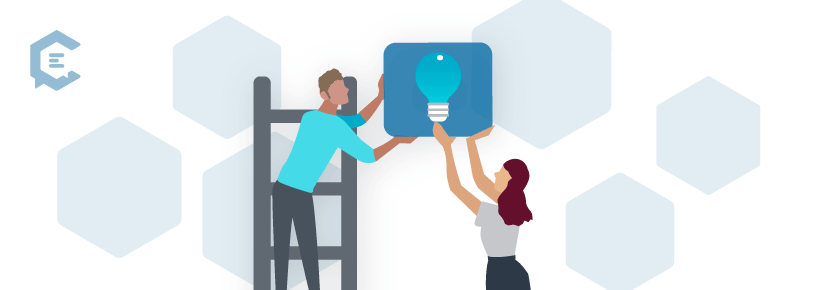At this point in the content marketing game, you know what it takes to gain serious traction. To drive more relevant traffic to your website and send quality leads straight to your sales team’s inbox, it takes lots and lots of damn good content.
Your content marketing team rocks and your team is fully-equipped to pump out credible content. But, your content campaigns just don’t have staying power. Consistency with production and publication haunts you every day. You want to feel positive momentum, but you feel totally stuck.
It’s time to tap into the power of teamlancing so you can create high-volume high-quality content, reach consistent success, and see a long-term pay-off.

Content marketing teams are small and they must be mighty.
Today’s content marketing teams are expected to perform ROI miracles with limited budgets and resources. Internal marketing teams simply don’t have the time, resources, and specialized skills to pull off large-scale content campaigns. Even if team members have specialized skills, they struggle to execute due to a myriad of other priorities and tasks under their care.
According to SEMrush, the majority (78%) of content marketing teams are quite small, consisting of 1-3 people, most commonly in these roles:
- A writer (52%)
- A social media manager (36%)
- An SEO content manager (34%)
This content marketing trio covers the bases but doesn’t support what really needs to happen to produce results… crank out high-volume content — not for a month or a quarter, but all year long.
Which is why, as also stated in the aforementioned SEMrush survey, 40% of teams must outsource content creation to meet the demand of ever-growing content marketing expectations.
These outsourcing needs usually include:
- Writing (53%)
- Graphic design (34%)
- Video design and animation (32%)
While teamlancing is technically a form of outsourcing, it is a much higher level of outsourcing. When you’re thinking in terms of high-quality high-volume content, you definitely want high-level content support.
Teamlancing fulfills a variety of roles at scale. It involves multiple third parties closely collaborating on all facets of the content production process, shoulder-to-shoulder with your internal content marketing team.
How do you scale content through teamlancing?
The next time a large-scale content initiative comes along, you have options with how you choose to work with teamlancers. Often this decision comes down to budget, but it also depends on your collaboration preferences for larger content campaigns.
Full outsource
Otherwise known as the whole teamlancing enchilada, this is your end-to-end content marketing solution.
In this teamlancing arrangement, you might hire a two-person consulting team as the primary strategists for various content campaigns. The two strategists handle creative direction and deliverables, everything from persona research and SEO to publishing and distribution.
Depending on the project, the two strategists partner with a designer/developer, videographer, or 10 writers. You communicate directly with the strategists — in fact, you will likely never talk to any of the other teamlancers working behind the scenes on the campaign.
Your main job is to review and sign off on deliverables and guide the strategic direction as needed. Overall, this teamlancing arrangement is collaborative on a high-level and fairly hands-off for you and your team.
Partial outsource
This engagement includes a mixture of working with one or more teamlancing entities and/or your internal content marketing team.
Let’s say you still hire the two-person consulting team we mentioned moments ago. Although they have the ability to lead and produce an entire content campaign from end-to-end, you decide you want to work with another teamlancing entity as well because you have worked with them on a previous project.
Or, perhaps your budget only allows you to work with the two-person consulting team and your internal content marketing team needs to handle certain aspects of the project.
In this teamlancing arrangement, more parties are involved so collaboration is constant. You manage more people and tasks, but you’re more controlling of the project as well. Partial outsourcing isn’t good or bad, it’s just more hands-on.
3 scalable content teamlancing scenarios
Teamlancing makes a lot more sense when you see how specific content scenarios might play out. Let’s look at how you can scale content with three different types of content campaigns by leveraging a support network of teamlancers.
1. Blog campaign
With blog content, what happens to most fatigued content marketing teams? They fail to keep up, because they are “pantsers,” a writing term for flying by the seat of your pants. They might have what it takes to blog, but they can’t plan and act far enough into the future. They blog weekly or monthly, rather than cohesively.
To get results from blog content, it goes without saying that quality content is needed. But, you need quality content to be consistent. At a minimum, plan on quarterly blog campaigns… or maybe even a 6-month or 12-month campaign. You can always adjust publication plans, bringing in-the-moment content into your editorial calendar at will.
When working with new teamlancers, you might be concerned about whether or not they will be able to deliver scalable content of this nature. See if the teamlancers will produce a smaller blog campaign first as a proof of concept. Then, you can move into a bigger engagement once the trust is there.
- Full outsource: Teamlancers handle persona research, topic research, SEO keyword research, content creation, on-page SEO, graphic design, social media strategy, social media, email distribution.
- Partial outsource: Pick and choose from the above list and your internal team fills in the gaps. Maybe go half and half with content creation on a quarterly blog campaign, where your team creates 12 blogs and your teamlancers take care of creating the other 12 blogs — along with formatting, publishing, and distributing your team’s internal content.
2. Case study campaign
We all know how important mid-funnel/Consideration content is for guiding buyers further down the funnel toward the point of conversion to the Decision stage. When internal teams are bogged down with top-of-funnel/Education content, where the heaviest content production transpires, Consideration content like case studies often fall off.
Case studies are tricky because you are essentially asking clients for a favor. And, you may not feel comfortable letting teamlancers into the creation of case studies because they will interact directly with clients.
So, what happens? You choose DIY. Then, you don’t have the time to create the content and/or you always feel like the timing isn’t right to ask your clients to participate. No case studies are created whatsoever.
Because your clients mean everything to your business, it’s okay to be apprehensive about bringing a third-party into the conversation. But, here’s the advantage of working with teamlancers on case studies… they are outside of the vendor/client relationship.
So, in many ways, it’s easier for teamlancers to get what is needed to tell a great customer story quicker than your team. They aren’t attached like you are. When you perform your next content audit and discover case studies are few and far between, work with teamlancers on a case study campaign to consistently produce and publish these key mid-funnel assets.
- Full outsource: Teamlancers handle topic discovery, client interview, transcription, SEO keyword research, content creation, on-page SEO, graphic design, social media distribution.
- Partial outsource: Commonly, the partial outsource with case studies means having your team perform the client interview because you only want the client to speak to someone who fully represents your brand. Again, there are pros and cons to this approach but you might fare better with a teamlancer leading the interview because they are an outside party.
3. Video campaign
Video content is intimidating to most content marketing teams for two reasons: budget and resources. Video costs will spiral out of control quickly as video content is easily the most expensive content to produce, far surpassing the blog and case study campaigns we just discussed.
The biggest misstep for internal content marketing teams? Thinking of video content as a one-off asset rather than a whole series, or video campaign. Episodic video content provides thematic consistency with your audience, hooking your audience with a binge-able format you know works with Netflix and Amazon shows.
A video campaign isn’t about a handful of videos, it’s about producing 25 or 50 or 100 and releasing content over a period of time. Episodic video content is a way to produce rich, flavorful content in a more cost-effective manner (compared to one-off videos here and there).
Teamlancing is arguably a must-have arrangement with any video campaign. Outsourcing video production teams have been the norm already since it’s rare to find in-house video content teams.
When you consider teamlancing for your next video campaign, you’re not just hiring a few people to produce videos. You’re hiring a creative army to manage all other aspects of the video campaign, like content strategists, scriptwriters, and SEO strategists (to name a few).
- Full outsource: Teamlancers handle video topic discovery, scripts, interviews, transcriptions, video production, post-production, captions, edit decision lists (EDLs), motion graphics, SEO, YouTube search optimization, publication, distribution, hosting setup, website design/development.
- Partial outsource: Unless you have internal video resources, you will lean on teamlancers for a lot of your video campaign. However, your team could take on some of the writing and promotional tasks — and, of course, be more involved in the EDLs.
Teamlancing is redefining the content production process, making it easier and faster for brands to scale content and achieve results. When you support your content strategy with teamlancing, you have a flexible, cost-conscious approach for getting the job done — with specialists whose entire livelihood depends on the exceptional work they produce for your organization.
More articles on the teamlancing model:
- What Is Teamlancing?
- How to Introduce Teamlancing to Your Company
- The Cross-Generational Teamlancing Ecosytem
- What Hollywood Can Teach Us About Teamlancing





